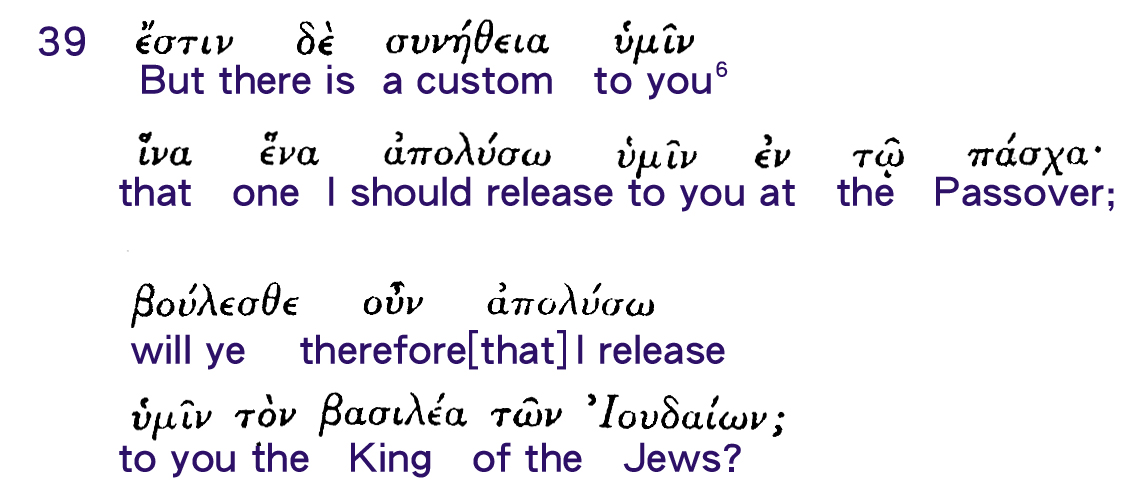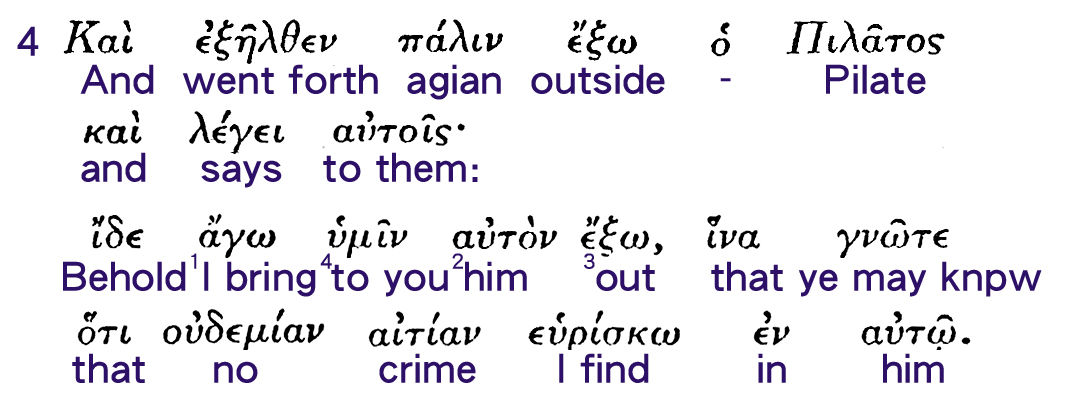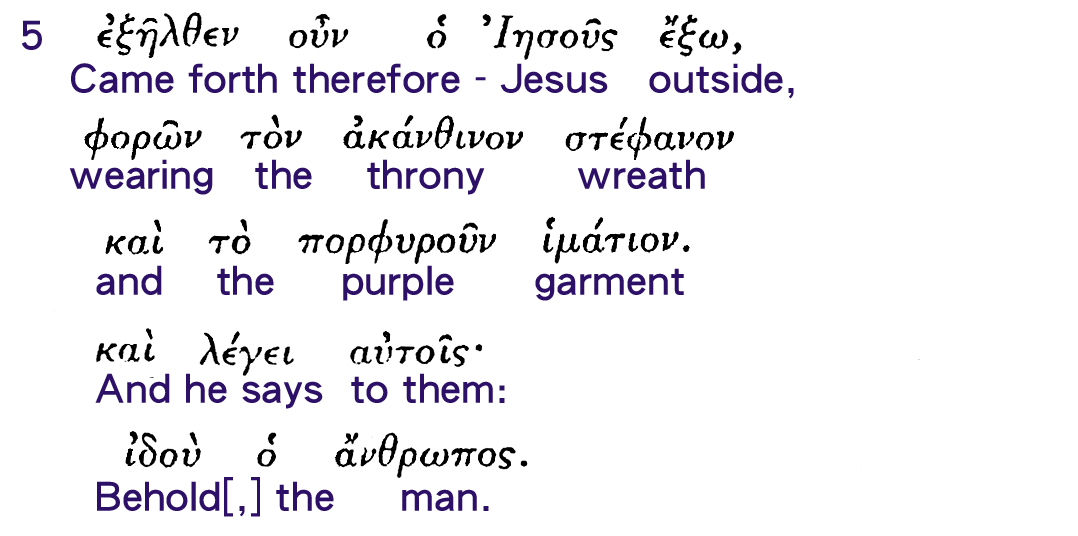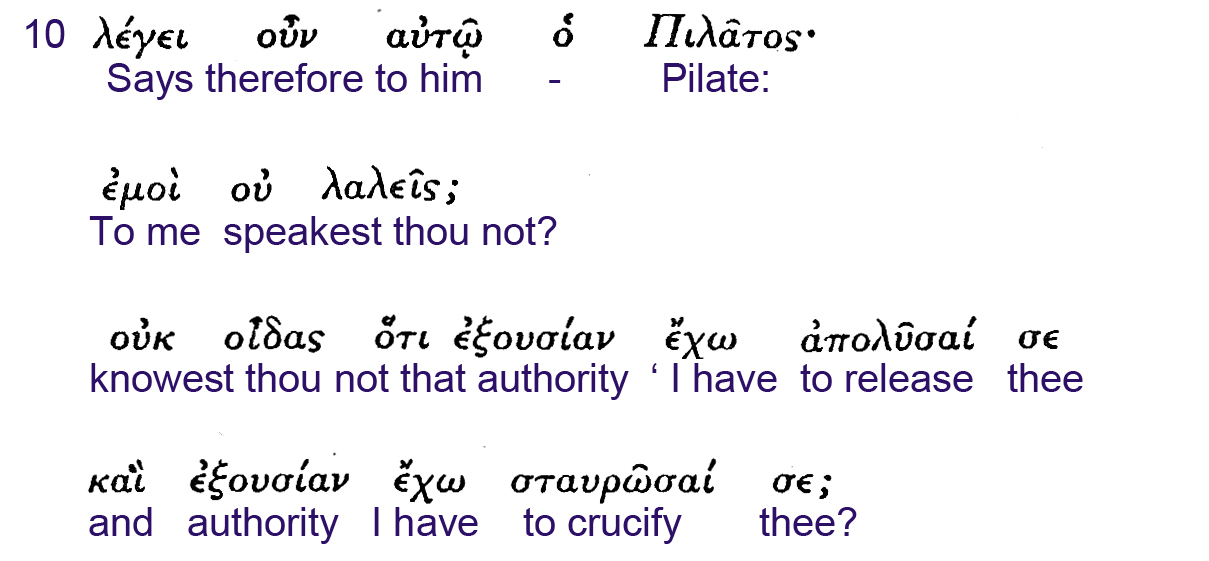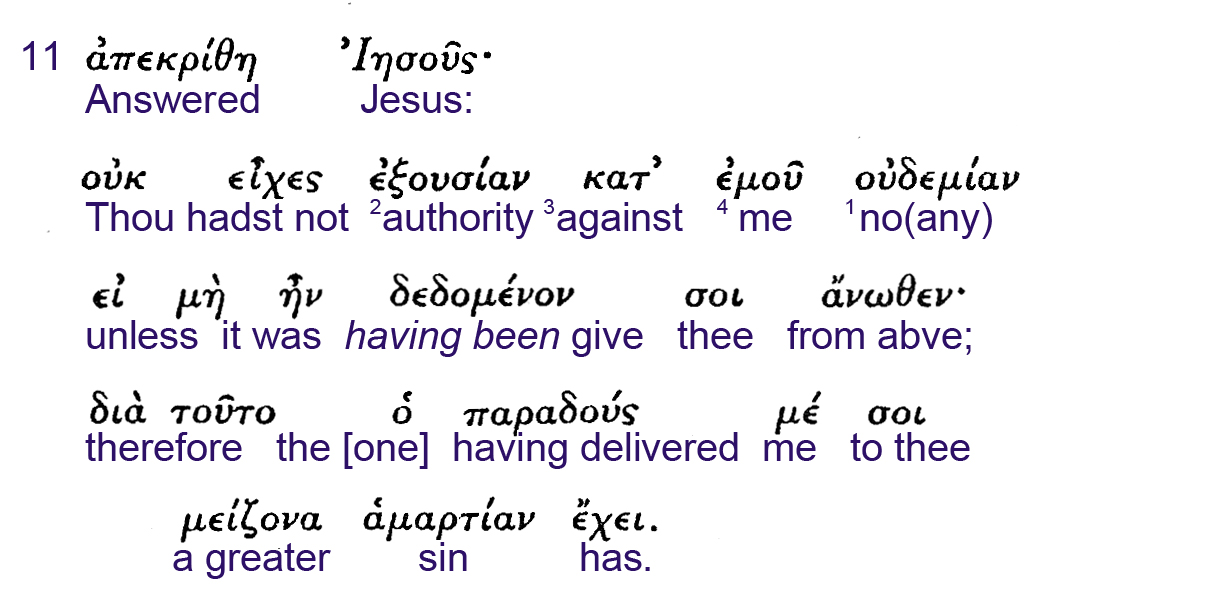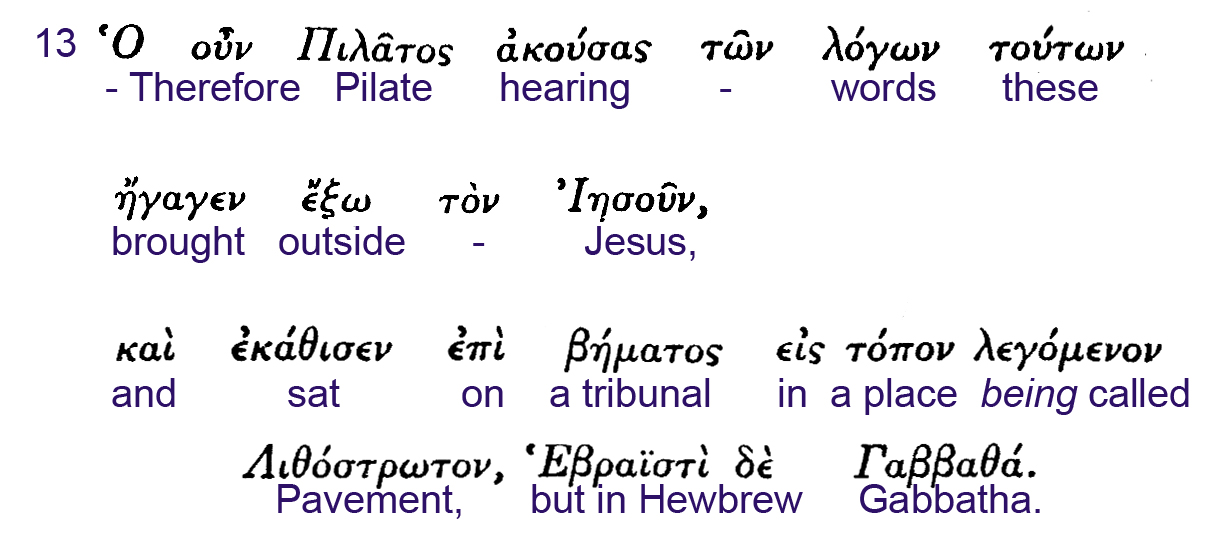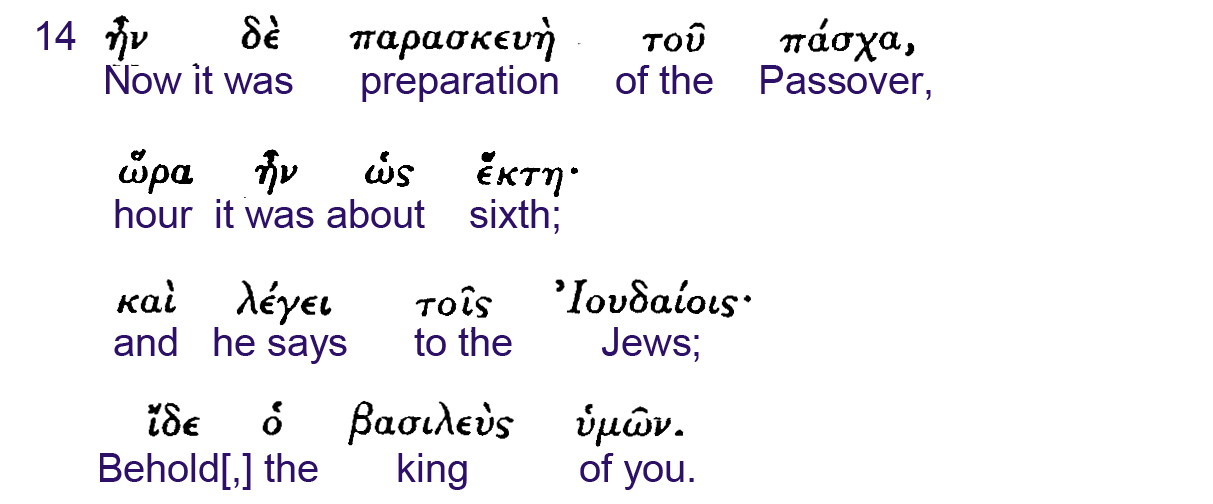PART TWO: ANALYSIS
4. Literary Analysis of the Text
With these preliminary considerations in mind, we set our theological inquiry in motion by first reading the text in an analytical way. We have three things to do. We first try to understand the division of the Gospel which furnishes the context of the text. In its turn, the context determines and enlarges the significances of the text. Secondly, we tackle the text itself and thirdly its structure in order to draw out the theological themes.
4.1 The Context
The collocation of the text tells us right away that the passage concerned is at the heart of the Book of Glory. It has three divisions: The Last Supper (chs 13-17): The Passion Narrative (chs 18-19): The Risen Jesus (20:1-19). The Passion narrative also has three divisions: The Arrest and Interrogation of Jesus (18: 1-27): His Ecounter with Pilate and the Jews (18:28-19:16c); The Crucifixion and Burial of Jesus (l9:16d-42) (32)The dramatic presentation of the trial which occupies the central place of the division is to be read in the context of the entire Gospel. And there are four important references to be borne in mind.
4.1.1 The Prologue
Schematically, I would like to present a sort of progressive parallelism between the prologue and the Trial regarding the identity of Christ. We can notice the difference between the believing readers of John who know well the Prologue and the actors involved in the drama of Jesus' Trial who heard the solemn proclamation of Christ without believing it.
| PROLOGUE | TRIAL |
| 1:1 The Word was with God | 18:36 My Kingdom is not of this World |
| 1:10 He was in the World | 18:37 For this I was born |
| 1:10 The World knew him not | 18:40 Not this man but Barabas |
| 1:14 We have beheld his glory | 19:5 Here is the Man |
| 1:14 glory as the only Son from the Father | 19:7 He has made himself the Son of God |
| 1:18 It is God the Only Son, who is in the Bosom of the Father | 19:14 Here is your King (then the crucifixion took place°–return to the Father). |
While in the Prologue there is a crescendo of revelation on God's side, there is another parallel crescendo of proclamation and disbelief in the Trial on the World's side. This is one of John's techniques to contrast two movements so as to urge his readers to get rid of a world-bound mentality and give room to faith.
4.1.2 The Book of Signs
After the Prologue, the story of the Gospel opens. There appear the witnessing statement of John the Baptist: "Behold, the lamb of God, who takes away the sin of/the world" (1:29): "And I have seen and have borne witness that W\s is the Son of God" (1 :34). We then find a series of confessions of faith:
1:38 Rabbi (= Teacher)
1:41 Messiah (=Christ)
1:45 We have found him of whom Moses in the Law and also the prophets spoke, Jesus of Nazareth
1:46 Rabbi You are the Son of God! You are the King of Israel!
All these confessions of faith are in the current categories of Jewish expectation. They are not denied by Jesus, but something more is indicated. The disciples are promised the sight (33)of the "greater things" (1:50-51) which will be realized in the passion when the Son of Man is lifted up and glorified (34). The promise is to be slowly realized as the Gospel unfolds. It will be worked out gradually during the whole of the public life of Jesus (cf chs 2-12), where the "signs" are to be seen. For John, seeing means a believing experience (35).
The Trial presents exactly tthese "greater things" to be seen
19:5 Behold, the Man
19:14 Behold, your King
The verb horao is always the same as that of 1:29: Behold the Lamb of God. and that of 1:51: You shall see greater things. All the earlier confessions are insufficient and to be integrated by the "sight" of the Man humiliated yet the King glorified.
4.1.3 The Last Supper
The narrative, here. seems to be addressed to a restricted audience of believers. It describes the climax of Jesus' life and of his "hour". John is keen on theologizing the time and circumstances. It was before the feast of Passover and the next day the slaughter of the paschal lambs took place, exactly the day of the Crucifixion. During the Supper, there occurred the Foot-washing. When Judas went out, "it was night" (13:30)-a phrase laden with theological, as well as chronological, signifcances (36). This time detail insinuates the prevailing darkness of the World. When Jesus was brought to the Roman Praetorium, it was "at dawn" (18:28)°–the Light comes to dissipate the darkness. When he was proclaimed, "Here is your King", it was noon on the day of preparation for the Passover(19:14)°–the Light was in full splendour and the Lamb was to be slaughtered.
Furthermore the farewell speech highlights the Trial scene:
14:3 to prepare a place for the disciples
16:28 the Son, thus, will return to the Father
17:4 Jesus glorifies his Father by fulfilling the Mission
17.5 The Father glorifies the Son by authenticating his Mission and by receiving him into his pre-existent Glory.
The Son's Mission, the Father's Authentication and the Return to prepare a place are all now focalized in the Trial-the death sentence of man's judgment and yet at the same time God's judgment taking place in man's, for whoever sees and believes the exalted (crucified) One may have eternal life.
4.1.4 The Resurrection
The identity of Jesus as Son, as Man and as King is further made clear in the appearance narratives (cf Jn 20). If Jesus is God's Son (19:7), then he is a Son dedicated to enlarging God's family. In returning to his Father and his God, he elevated his followers as his brothers, having the same Father and the same God. The relationships between Jesus and his followers are increasingly put into evidence:
13:16 The disciples are likened to servants in the Foot-washing
15:14 They are called friends for whom Jesus would lay down his own life
20:17 Now in returning to the Father, he elevates them as brothers.
As the Son imparts to his disciples the Holy Spirit, he gives them also the Mission that his Father has given to him°–the forgiveness of sins which is the condition of entering the Kingdom of God. John identifies the Christ in the Trial with the Risen One. Thus, it is the 'glory" of the Risen Christ that tints the Trial setting.
4.2 The Text
The text is taken from Eberhard Nestles's Novum Testamentum Graece, 21st edition (37).As for the textual criticism, I principally adopt B.M .Metzger, A Textual Commentary on the Greek New Testament (London 1975). Some remarks in the philological notes will also be taken from J. Mateos°–J. Barreto. II Vangelo di Giovanni. Analisi Linguistica e commento esegetico (Assisi 1982).
4.3 The Structure
The criterion for dividing the passage, according to most biblical scholars, depends on the personages in the scenes, places and the verbs (38)
The continual use of verbs of motion agousin, eiselthen, exelthen°Kdivides the drama into seven scenes:
| 1: The JEWS demand Jesus' DEATH (18:28-32) |
7: The JEWS obtain Jesus' DEATH (19:12-16b) |
Actors: Jesus, Pilate and the JEWS Place: Outside the Praetorium |
|
| LIGHT: at day break (28b) |
LIGHT: the sixth hour (= noon) (14b) |
| LAMB: the Passover (28d) |
LAMB: the day of the slaughter (14a) |
| DELIVERED (paradidomi) by the JEWS to Pilate (30c) |
DELIVERED (paradidomi) by Pilate to the JEW(16d) |
| (KING): Jesus is accused as an evildoer (30c) |
KING: "Here is your KING" (14d) |
| JUDGMENT: Pilate refuses to judge while the JEWS had no power to judge (31) |
(JUDGMENT): Pilate made Jesus sit down on the Tribunal (13c): the rest became the judged |
| (CRUCIFIXION): The JEWS demand Jesus' death (31) and Jesus knows about His death (32) |
CRUCIFIXION: that He should be crucified (16b) |
2: Pilate questions |
6: Pilate questions Jesus about AUTHORITY (19:9-11) |
Actors: Jesus and Pilate Place: Inside the Praetorium |
|
| KING-question: "KING OF THE JEWS?" (33c) Jesus corrects Pilate by turning his political investigation into a religious quest |
KING-question: "Where are you from?" (9b) It is a religious inquiry; Jesus' silence leaves Pilate to decide |
| AUTHORITY: Pilate's boast of his authority (16) |
|
| KINGSHIP: "not of this WORLD" (36b) "You say that I am a KING" (37d) |
"FROM ABOVE" (11c) "You have no authority against me" (11b) |
| TRUTH: Jesus' witness to the TRUTH (37g); he who is of the |
|
| TRUTH hears His voice (37h); "What is TRUTH?" (38b) |
|
| 3: Jesus is innocent. Barabbas but not the KING OF THE JEWS (18:38c-40) |
5: Jesus is innocent. "Behold, the MAN" "Crucify Him!" (19:4-8) |
Actors: Jesus Pilate and the JEWS Place: Outside the Praetorium |
|
| INNOCENCE: I find no crime in HIM (38d) |
INNOCENCE: No crime in HIM (4b, 6e) |
| KINGSHIP: Choice between Barabbas and |
KINGSHIP: "Here is the MAN" |
| REFUSAL: The Jews reject Jesus for they prefer Barabbas, a robber (40) |
|
| REFUSAL: "Crucify Him. Crucify Him" They reject Jesus as the "SON OF GOD" (6b. 7d) |
Pilate's uneasiness is here implied Pilate's fear is here more explicit (8) |
| 4: Jesus is scourged, crowned, clothed and mocked as KING of the JEWS (19:1-3) |
|
Actors: Jesus and the soldiers Place : Inside the Praetorium |
|
| The scene is a subtle piece of irony that describes that °–Jesus is the real KING, but not of this WORLD °–the crowning and clothing of Jesus fit into the solemn proclamation "no crime in HIM" (19:4.6) "Here is the MAN" (19:5) "Here is Your KING" (19:14) |
|
As we may notice, this is only a proposed structure presenting a chiastic-circular movement.
"There is a very careful balancing in setting, content, and even in length (1=7; 2+3=5+6). The only episode in which Pilate does not figure prominently is 4, the middle episode. Obviously the hand of a meticulous planner has been at work here"(40).
In these 7 scenes, there \re many possible themes such as Light, Lamb, Delivered, Judgment Kingship, Truth, Revelation, Belief and Disbelief, Above and Below, Authority, the Man, God's Son, Crucifixion, and the like. In order not to lose sight of our original inquiry, the Identity of Christ in the Trial, we try to organize these themes on Christ into four headings:
(1) Christ, the Revealer
who came to the WORLD from ABOVE, as the LIGHT in the DARKNESS, as the LAMB of God who takes away our sins and as GOD'S SON who REVEALS to us the TRUTH.
(2) Christ, the King Glorified
who CAME to restore the Eschatological KINGDOM which takes place in the event of the CRUCIFIXION, where the SON OF MAN is LIFTED UP. He is the Eschatological Protagonist (cf Dan 7:13-14)to whom is given the POWER, the KINGDOM and the GLORY in order to regin universally. His GLORY takes place in the CRUCIFIXION, which is the great ACCOMPLISHMENT of the Salvific Plan of God for it is a Glorious RETURNING to the Father.
(3) Christ, the Judge
who for the JUDGMENT came to the WORLD (9:39). His JUDGMENT is not to condemn but to justify those who BELIEVE. Though submitted to the LAW, he does not JUDGE according to the LAW but according to GRACE and LOVE.
(4) Christ, who comes to provoke FAITH
and invites' us to adhere to the TRUTH to which he TESTIFIES through signs and words. He helps those who fall short of FAITH, but before HIM one must inescapably make a DECISION OF FAITH (41)
Now a sort of schematical synopsis, we try to see how these four themes are interwoven together around the Figure of Christ.
We shall divide the text of Jn 18:28-19:16 according to the following headings:
1. the Jewish authorities ask Pilate to condemn Jesus.
2. Pilate questions Jesus about Kingship (cont.)
3. Pilate seeks to release Jesus; the Jews prefer Barabbas.
4. (Intermediary) The Roman soldiers scourge and mock Jesus.
5. Pilate presents Jesus to his people; the Jews shout for crucifixion.
6. Pilate talks with Jesus about power.
7. Pilate yields to the Jewish demand for Jesus' crucifixion
1. The Jewish authorities ask Pilate to condemn Jesus. 18:28-32 |
|
REVELATION |
GLORIFICATION |
JUDGMENT |
FAITH |
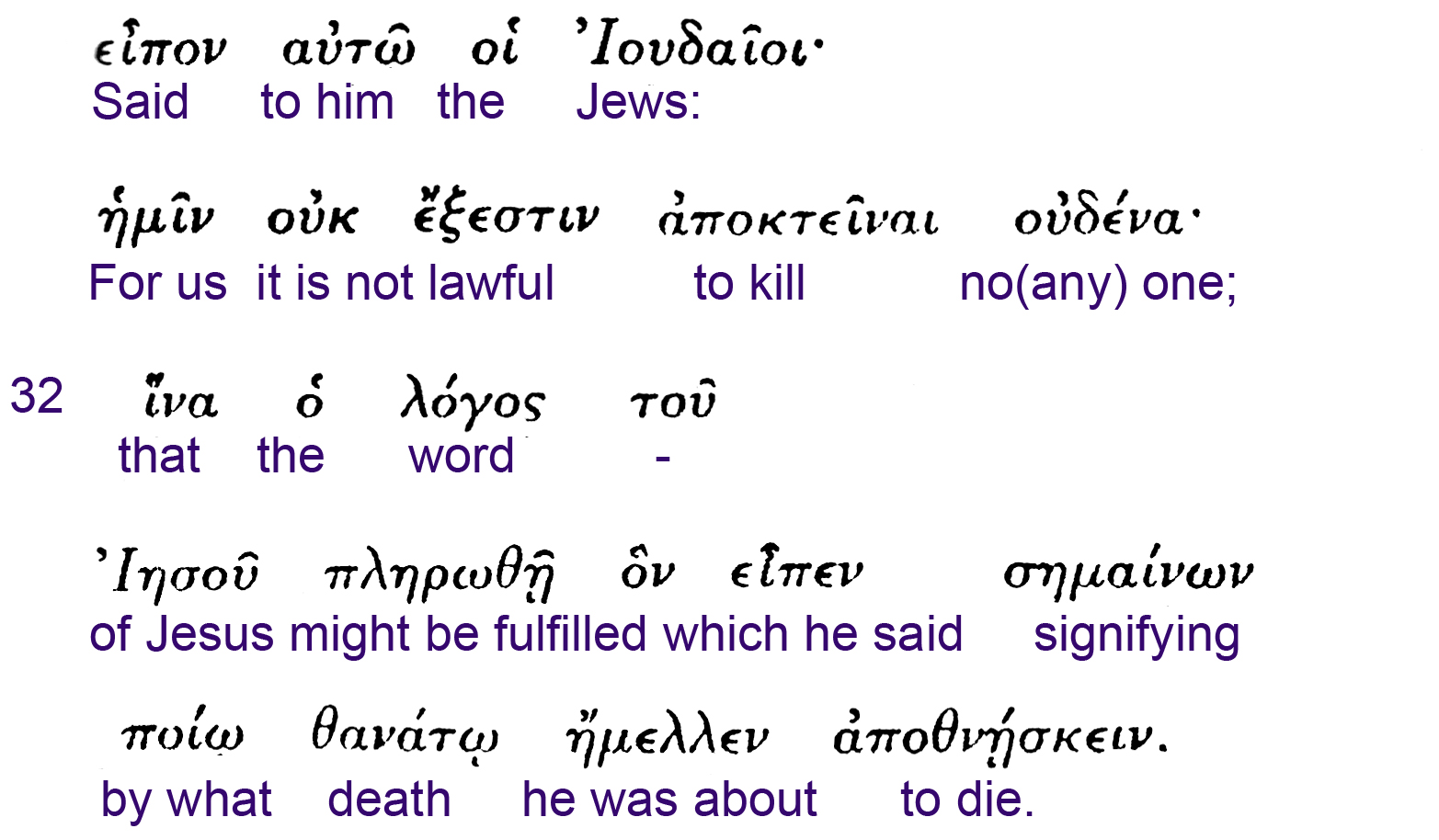 |
Towards Pretorium: the LIGHT shines in the darkness(1:5; 13:30). Ready to eat the Paschal LAMB (1:29). See also.19:14 |
Jesus is DELIVERED by Judas, now by th JEWS.
The JEWS intend the DEATH of Jesus (11:50): |
The TRIAL begins, JESUS is to be judged: accused by the JEWS. Jesus as Evil-doer.
Pilate refuses to judge and the JEWS cannot jude (for Jesus is real JUDGE) |
Jesus is REFUSED by the JEWS-the World
Pilate wants to be NEUTRAL. |
|
| 2. Pilate questions Jesus about Kingship (cont.). 18:3738b | ||||
 |
REVELATION |
GLORIFICATION |
JUDGMENT |
FAITH |
|
||
The FULFILMENT of Jesus' WORD (3:14, 8:28; 12:32s): the CROSS - the climax of REVELATION.
The question betrays Pilate's interest still in earthy matters. Apparently Jesus did not say Yes or No, but affirmed that His coming into the World is to reveal the TRUTH, because He is come from above (3:13; 8:23); He knows the father (8:26); He is the |
a glorious death to save the whole Nation.
Jesus does not deny His KINGSHIP, but links it to His witness to the TRUTH. |
Pilate returns to His own question.
Without giving a diresct reply, Jesus presents Himself as the withness to the TRUTH so that Pilate should decide for or against the TRUTH. Jesus' judgment consists in the decision for or against His witness |
Pilate still fell short of FAITH.
Jesus helps him by showing that His being in the World is to prvoke FAITH, so that he who believeds in Him may have eternal life (3:16). |
|||
| 3.Pilate seeks to release Jesus; the JEWS perfer barabbas (18:38c-40) | ||||||
 |
||||||
REVELATION |
GLORIFICATION |
JUDGMENT |
FAITH |
|
||
TRUTH (14:6); His DEATH wil be its supreme testimnoy (8:28)
The JEWS symbolize the World to which the TRUTH is revealed but which does not accept it. |
The listening to Hsis voice (10:3) has an OT background fo the KINGSHIP (Ez 34) |
With this question Pilate tries to avoid the decision. |
Pilate wants to remain indifferent. |
|||
REVELATION |
GLORIFICATION |
JUDGMENT |
FAITH |
19
|
||
| Pilate proclaims Jesus' INNOCENCE (19:4.6). |
Pilate foretells an innocent death, though not consciously. |
Offically Jesus is no lnger on TRAIL, for he is innocent. |
||||
| The title KING is admitted by the Romans (19:3). | Jesus as the KING of the JEWS. | The KING becomes the JUDGE insofar as the JEWS(= World) have to decide between Jesus and Barabbas.
|
Pilate tries to avoid the decision between the World (=the JEWS) and the TRUTH (=Jesus). | |||
|
Ironiaclly, failing to give Jesus justice Pilate is forced to make a travety of justice. |
Pilate cannot remain netural bt follows the World. | ||||
REVELATION |
GLORIFICATION |
JUDGMENT |
FAITH |
|||
| The scourging recalls the fulfilment of the suffering SEVANT (Is 50:6). | The mockery and scourging are telling evidence of Jesus' willingness to drink the chaltce of the Father. (18:11) |
The JUDGE suffers injustice. |
The scourging seems to be a benevolent plan for Jesus' release but reveals Pilate's attitude of trying to save the TRUTH while complying with the World.
|
|||
Ironically, through the gestures of the mockers, the TRUTH of Jesus' KINGSHIP is revealed.
|
The son GLORIFIES the Father by fulfilling His Will (17:4) | The Crown of throns and the purple cloak prepare the solemn judging scene in (19:12-16a). |
5. Pilate Presents Jesus to his people; the Jews about for the crucifixion. (19:4-8) |
|||
|
||||||
The unconscious proclamation of Jesus' KINGSHIP is a sign that the Gentiles will Unti- |
One can recognize Jesus' PASSION as GLORY as far as one confesses the KINGSHIP of the |
|
The scene shows the irony of confessing the TRUTH of faith without believing in it. | |||
REVELATION |
GLORIFICATION |
JUDGMENT |
FAITH |

|
||
| mately confess Jesus as the KING. | RISEN CHRIST. For John it is the RESURRECTION that determines the content of the PASSION (17:1-5). | |||||
The KING is revealed as the MESSIAH, for "MAN" here is another Messianic title, as that of the SON of MAN in whom the LOVE of GOD is the be man- |
The second declaration of Jesus' INNOCENCE The Same is repeated in 18:38; 19:6. |
The title MAN could be eschatological for one who has also a judging role (LXX zech 6:12f).
Ironcially, when Pilate refused a political. |
At the begining of the minstry in 1:35-51 titkes were given to Jesus as the FAITH of the disciples grew; (these include SON of GOD, SON of MAN, KING of ISRAEL). Now, at the end of His life, in a cressendo of disbelief, Jesus is mockingly or incredulously called the KING OF THE | |||
6. Pilate talks with Jesus about power. 19:9-11 |
||||||
 |
||||||
REVELATION |
GLORIFICATION |
JUDGMENT |
FAITH |
|
||
ifested. So the long waited Messianic KING comes to ironic FULFILMENT.
Jesus as the SON of GOD, though refused by the greatest REVELATION (1:18; 3:16).
Pilate comes to a real TRUTH-searching question. |
The SON of MAN is glorified when He is exalted(= crucified) because while re-turing to the Father, His pre-existent glory Him to the Father (3:13; 8:28; 12:23; 8:28; 12:23, 32, 34).
From the question "what did you do?" (18:35e) to the question |
charge, the JEW fell back on the religious charge, which Pilate finally accepted under political presure.
By refusing Jesus as the SON of GOD, the JEWS judge themsleves.
After hearing the religious charge, Pilate interrogates Jesus again. |
JEWS, the MAN, and the SON of GOD.
Pilate's fear is also due to his religious instinct.
By this question Pilate perhaps still tries to find a legal loophole |
|||
REVELATION |
GLORIFICATIO |
JUDGMENT |
FAITH |
|
||
The Silence recalls, in FULFILMENT, the Suffering Servant Is 53:7. |
"Where are you from? "(9b), i.e., a from politcal investigation to that of "FROM ABOVE". |
The momentary silence shows that Pilate is on TRIAL and he has to decide. |
To save Jesus (see LK 23:6,where he asked if Jesus came from Galilea so as to send Him to Herod). But here it lends itself also to a theological inquiry whether Jesus cmes FROM ABOVE.
It is a religious wonder caused by fear (19:8). |
|||
| 7. Pilate yields to the Jewish demand for Jesus' crucifixion. 19:12-16ab | ||||||
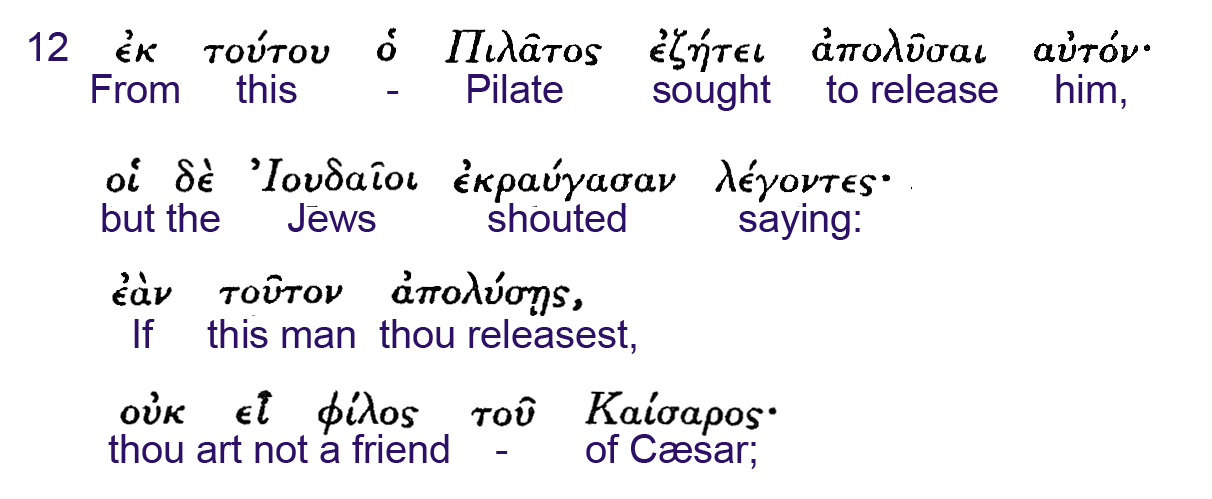 |
||||||
REVELATION |
GLORIFICATIO |
JUDGMENT |
FAITH |
|
||
Jesus reveals the AUTHORITY FROM ABOVE, because He comes FROM ABOVE (1:14,17; 3:13)
Jesus speaks with AUTHOIRTY. |
Jesus glorifies His father by complying with His will FROM ABOVE.(17:4). |
A JUDGMENT is given on those who refuse Christ radically (12:31). |
The fear causes Pilate to bluster about his earthly authority. Jesus corrects him.
Pilate, charged with misusing his God-given power, tries to release Jesus. |
|||
REVELATION |
GLORIFICATIO |
JUDGMENT |
FAITH |
|
||
It is the day for the slaughter f the LAMB. the HOUR for the LIGHT to shine in full: Here is your KING. |
The CRUCIFIXION is the EXALTATION, for the son fulfils the Father's Will and Father receives the Son into GLORY.
Jesus is now DELIVERED by Pilate. |
The text lends itself to a JUDGMENT-scene where Jesus acts as JUDGE (sitting on the Tribunal) and the rest are the Judged. |
This Prompts the JEWS to renew their political blackmail.
Pilate finally is submitted to the WORLD (=JEWS), for he perfers his power to the TRUTH.
The JEWS pushing esus to death, are forced toabandon their Yahweh-KING (againstIs 26:13) |
|||






